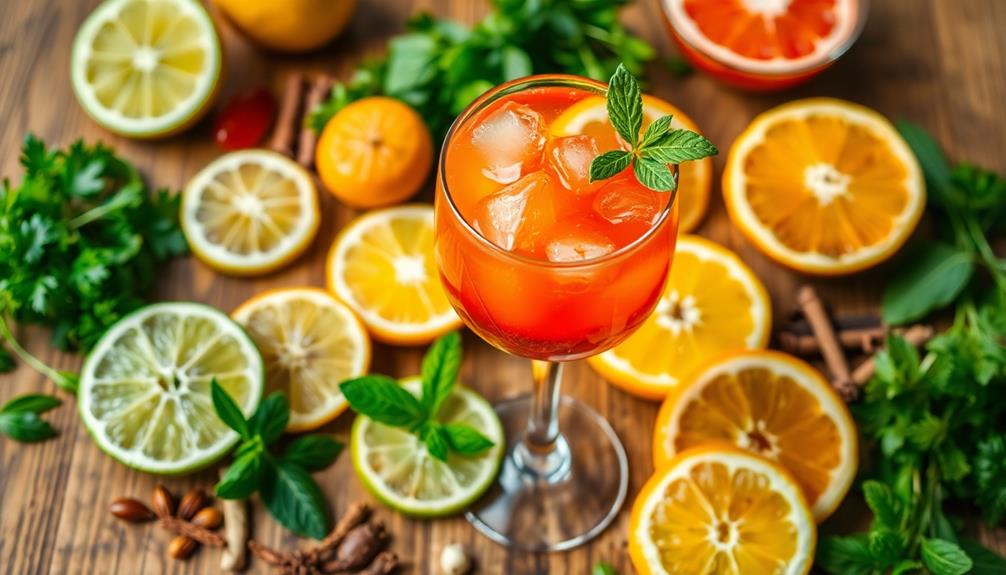The art of pairing food with cocktails involves finding a balance and enhancing flavors. Consider factors such as sweet, sour, and umami profiles when planning to make your meal more delightful. Sweet cocktails work well with roasted meats, while sour ones can help cut through rich flavors. It’s important to think about the body and texture of both the dish and cocktail – lighter meals go well with lighter drinks. Trying out unique combinations can result in delightful surprises, such as pairing a Mint Julep with fried chicken. There’s a world of possibilities to explore, and experimenting with these principles can lead to some tasty discoveries.
Key Takeaways
- Understanding flavor profiles, including sweet, sour, salty, bitter, and umami, is essential for effective cocktail and food pairings.
- Balancing contrasting and complementary flavors can enhance the overall dining experience and enjoyment of both food and cocktails.
- Matching the body and texture of cocktails with the intensity of dishes elevates the tasting experience, ensuring harmony.
- Sweetness in cocktails should balance or exceed that of dishes, particularly desserts, to enhance flavors and avoid overpowering them.
- Experimenting with unique combinations and using a flavor wheel can lead to innovative and adventurous pairings that surprise the palate.
Understanding Flavor Profiles
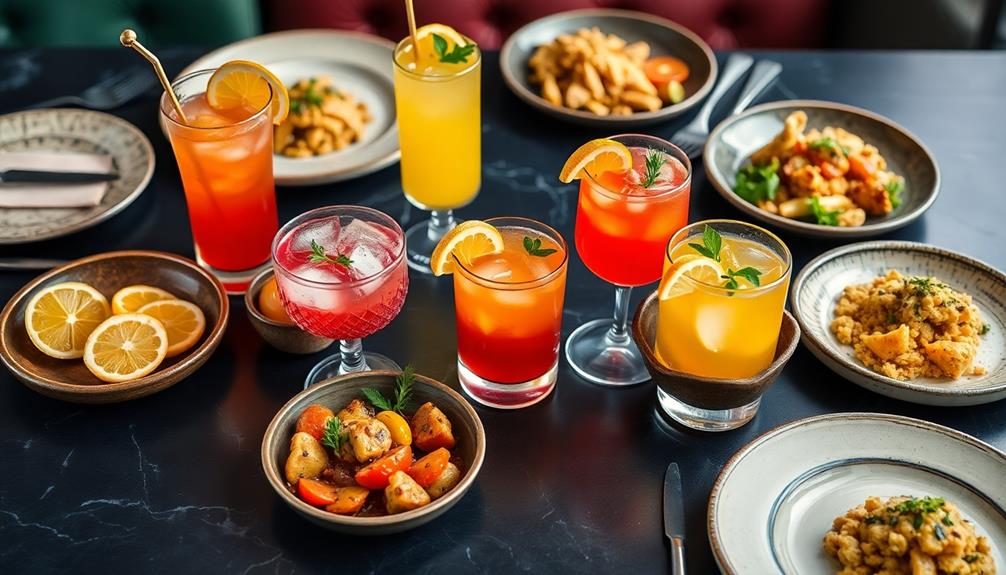
When you think about food and cocktail pairings, understanding flavor profiles is essential. Each profile—sweet, sour, salty, bitter, and umami—plays a crucial role in enhancing your experience with food and cocktails.
For instance, the vibrant flavors found in dishes like Chilaquiles can be beautifully complemented by cocktails that highlight sour or spicy notes, creating a harmonious balance. Sweet flavors in cocktails can beautifully complement roasted meats and desserts, creating a harmonious balance. On the other hand, sour notes add vibrancy, cutting through rich or overly sweet dishes, elevating the overall taste.
Salty flavors are equally important; they enhance and draw out subtle notes in both food and cocktails. A salty rim on a cocktail can transform the drink, making it a perfect partner for certain dishes. Bitter components in cocktails provide depth, especially when paired with sweet desserts or umami-rich foods, offering a satisfying contrast.
Speaking of umami, this savory taste lends richness and depth, making it particularly effective with cocktails that share complementary flavors, like those containing tomato juice.
Techniques for Successful Pairing
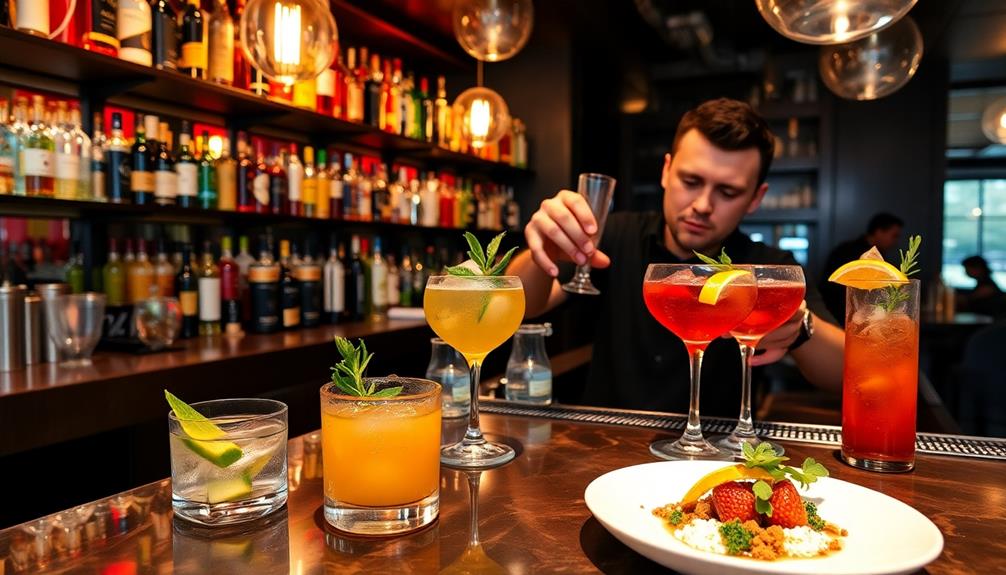
When you're pairing food with cocktails, think about contrasting flavors to really elevate your experience.
For example, a rich dish like a Loaded Baked Potato can be perfectly balanced with a revitalizing cocktail that has citrus notes.
You can also explore complementary techniques that bring out the best in both your dish and drink.
Don't forget to balance the intensity levels; a strong cocktail deserves a hearty meal, while a lighter drink pairs well with something more delicate.
Contrasting Flavor Profiles
Exploring contrasting flavor profiles can elevate your cocktail and food pairings to new heights. By intentionally contrasting the flavors, you can create a dynamic experience that excites your palate.
For instance, pairing a tart cocktail with a rich, creamy dish balances textures and tastes beautifully, such as enjoying a rejuvenating drink alongside a rich dish like Red-Braised Pork Belly, where the drink's acidity cuts through the meat's richness. A spicy margarita alongside sweet and smoky barbecue ribs exemplifies this concept, where the drink's acidity cuts through the meat's richness.
Think about how different intensities play a role in your pairings. A light, citrusy cocktail can complement a hearty, savory dish without overpowering it.
Alternatively, match a bitter cocktail like a Negroni with fatty charcuterie to balance richness with sharpness.
Don't shy away from experimentation! Unpredictable combinations often lead to delightful surprises.
For example, a sweet cocktail paired with salty snacks can enhance both elements, making for a memorable experience.
Keep these principles in mind, and you'll find that contrasting flavor profiles not only enhance your cocktail and food pairings but also invite your guests to explore new tastes they might never have considered before.
Complementary Pairing Techniques
Enhancing your dining experience through complementary pairing techniques can transform a meal into a memorable occasion. By selecting cocktails that elevate the primary flavors of your dish, you create a harmonious balance that enriches both the cocktails and food.
For instance, pairing a revitalizing gin and tonic with a classic Brazilian dish like Caldeirada beautifully complements the delicate seafood flavors. A successful pairing matches the intensity of your cocktail with the weight of your dish; for example, a light gin and tonic beautifully complements delicate seafood.
Utilizing acidity in cocktails is another effective strategy. A citrus-based drink, like a Whiskey Sour, cuts through the richness of fatty foods, enhancing your enjoyment of dishes like barbecue ribs.
Sweet cocktails can also elevate your meal, as a Mai Tai pairs wonderfully with caramelized notes in grilled pineapple or pork.
Lastly, identifying flavor profiles is essential. By matching herbal notes in a gin cocktail with fresh herbs in a salad, you create a cohesive taste experience that showcases the best characteristics of both elements.
Embrace these complementary pairing techniques to elevate your dining experience, ensuring each sip and bite work together harmoniously.
Balancing Intensity Levels
Successfully balancing intensity levels in food and cocktail pairings is essential for a delightful dining experience. When you match the intensity of your dish with the strength of your cocktail, you guarantee that neither overpowers the other.
For example, pairing a light-bodied cocktail like a gin and tonic with delicate dishes such as sushi or traditional Japanese sweets can enhance the overall experience.
Here are some techniques to take into account:
- Match Light with Light: Pair light-bodied cocktails, like a gin and tonic, with delicate dishes such as sushi.
- Match Rich with Rich: Full-bodied cocktails complement richer foods; think of an old fashioned with a juicy steak.
- Take into Account Acidity: Use bright, acidic cocktails to cut through richness. A whiskey sour works well with fatty foods like barbecue ribs.
- Experiment with Contrasts: Try surprising combinations, like a heavy cocktail with light appetizers, such as a dark rum cocktail with shrimp cocktails.
Impact of Body and Texture

The body and texture of cocktails play an essential role in food pairing, as they can greatly influence your dining experience. The body of a drink refers to its weight and richness—light, medium, or full-bodied. To create ideal pairings, you should match the drink's body to the food's impact. For instance, lighter foods like salads or seafood typically work well with lower-alcohol, lighter-bodied cocktails. In contrast, richer dishes such as steak are best complemented by full-bodied drinks.
When it comes to Italian cuisine, pairing cocktails with hearty dishes like braised beef in Barolo wine can enhance the overall flavor profile of your meal.
Texture is equally important; it can enhance or contrast with the food's texture, making every bite and sip more enjoyable. Creamy cocktails can provide a luscious mouthfeel that pairs beautifully with smooth dishes, while frothy drinks can add a revitalizing element. If you're indulging in rich or greasy foods, opt for cocktails with carbonation, as the bubbles can cleanse your palate effectively.
Finding the right balance between the body of your cocktail and the texture of your meal is vital. A heavy cocktail can easily overwhelm a delicate dish, while a light drink might get lost beside a robust meal. Aim for harmony to elevate your dining experience.
The Role of Sweetness
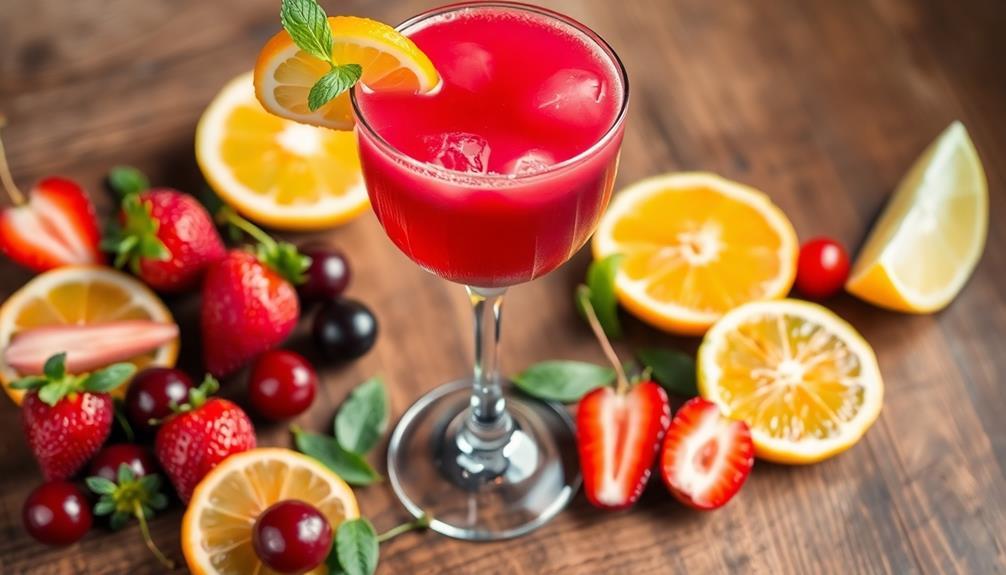
Sweetness plays a vital role in balancing flavors, especially when it comes to pairing cocktails with food.
You'll find that sweeter drinks can enhance spiced dishes by soothing the palate, while also perfectly complementing desserts like Kue Putu or Dadar Gulung.
Understanding how sweetness interacts with different food elements can elevate your dining experience. The balance between sweet flavors and other components like acidity, bitterness, and umami can create more harmonious and satisfying dishes. Incorporating natural sweetness into meals, particularly when paired with foods that boost brainpower, can enhance not only the taste but also the nutritional benefits. For example, combining dark chocolate, rich in antioxidants, with berries or nuts offers both cognitive and sensory rewards.
Sweetness in Flavor Balance
When it comes to crafting the perfect cocktail, sweetness plays an essential role in achieving a balanced flavor profile. It enhances your overall dining experience by complementing rich, savory, or spicy foods like Mushroom Masala, which is known for its earthy flavors and spice blend.
A well-balanced drink can elevate your meal, making it more enjoyable. Here are some key points to reflect on when incorporating sweetness:
- Sweetness vs. Food: Make certain your cocktail is sweeter than the dish, especially with desserts, so the drink doesn't overpower the flavors.
- Counteracting Heat: Sweet cocktails can effectively counteract heat in spicy dishes, creating a more harmonious balance.
- Enhancing Umami: Cocktails like the Mai Tai, with their sweet notes, can provide a pleasing contrast to umami-rich foods.
- Balancing Acidity: Sweetness helps balance acidity, allowing cocktails to complement rich and tangy dishes like barbecued meats or citrus-dressed salads.
Enhancing Spiced Dishes
Pairing cocktails with spiced dishes can elevate your dining experience to new heights. The key lies in incorporating sweetness into your drinks. Sweet flavors counterbalance the heat from spicy dishes, softening the overall spiciness on your palate.
For instance, a slightly sweet cocktail like a Mai Tai can provide the perfect foil to the fiery notes in your meal, creating a harmonious blend that enhances both elements. When enjoying dishes like bulgogi or spicy kimchi, the sweetness in your cocktail can greatly enhance the flavor profile, allowing the marinated richness to shine through.
When you sip on a cocktail with residual sugar, you'll notice how it amplifies your enjoyment of spiced foods. The sweetness helps to mellow sharp flavors, allowing the underlying richness of the dish to emerge. This balance makes the spices feel less overwhelming while highlighting their complexity.
Additionally, utilizing sweet elements in your cocktails elevates the entire dining experience. The contrast between the sweetness of your drink and the heat of your food not only enhances your palate but also adds depth to your meal.
Pairing With Desserts
Finding the right cocktail to complement your dessert can transform a simple treat into a memorable indulgence. When selecting from your cocktail menu, remember that the drink should generally be sweeter than the dessert. This prevents the cocktail from tasting thin or bitter, especially with rich, sugary treats.
For example, a luscious dessert like Nettle and Potato Soup can be beautifully paired with a sweet cocktail that enhances its creamy texture.
Here are some tips for pairing cocktails with desserts:
- Choose sweet cocktails: Opt for those with fruit liqueurs or dessert wines to enhance flavors and counteract any spiciness in the dessert.
- Balance creamy desserts: For treats like panna cotta, cocktails with smooth sweetness—think vanilla or cream liqueurs—harmonize beautifully.
- Consider off-dry wines: These can provide a delightful contrast for slightly sweet desserts, balancing the richness without overwhelming the palate.
- Highlight flavor profiles: Pair a Mai Tai with tropical fruit desserts to elevate the overall experience through shared flavors.
Balancing Acidity and Richness
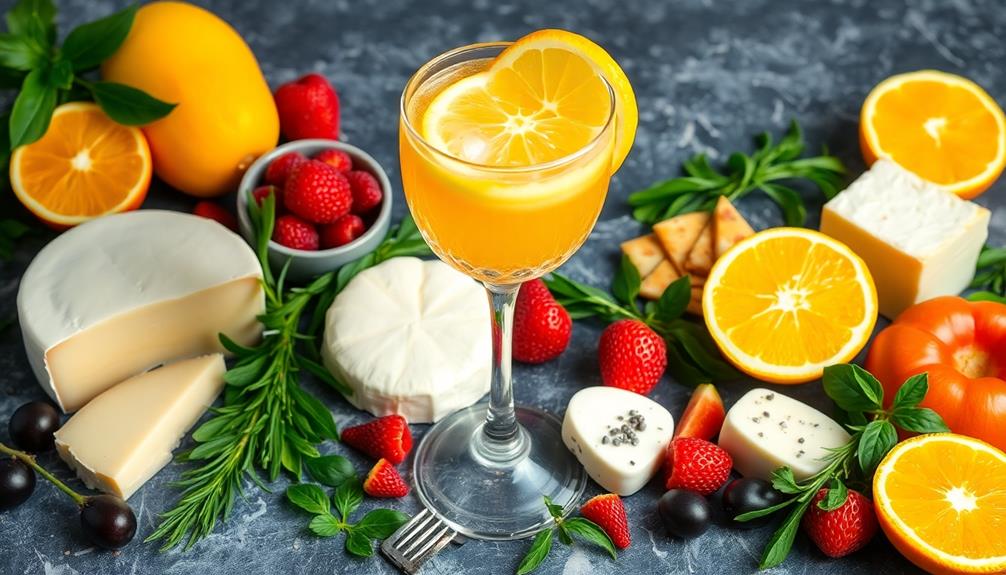
Balancing acidity and richness in your food and cocktail choices can transform your dining experience. When you select cocktails with a high acidity, like a Whiskey Sour, you effectively enhance the freshness of your meal.
These acidic elements cut through the richness of fatty foods, making dishes like barbecue ribs and creamy sauces more enjoyable. High-acid cocktails refresh your palate after each bite, preventing the meal from feeling overly heavy.
When you pair a rich dish with an acidic drink, you create a harmonious balance that amplifies the flavors of both. Think of how citrus juices in cocktails can complement the richness of fried dishes, allowing you to savor every element without overwhelming your taste buds.
The right level of acidity not only elevates your cocktail but also enhances the overall dining experience. It works to brighten and enliven your meal, making it more satisfying.
Classic Cocktail and Food Pairings
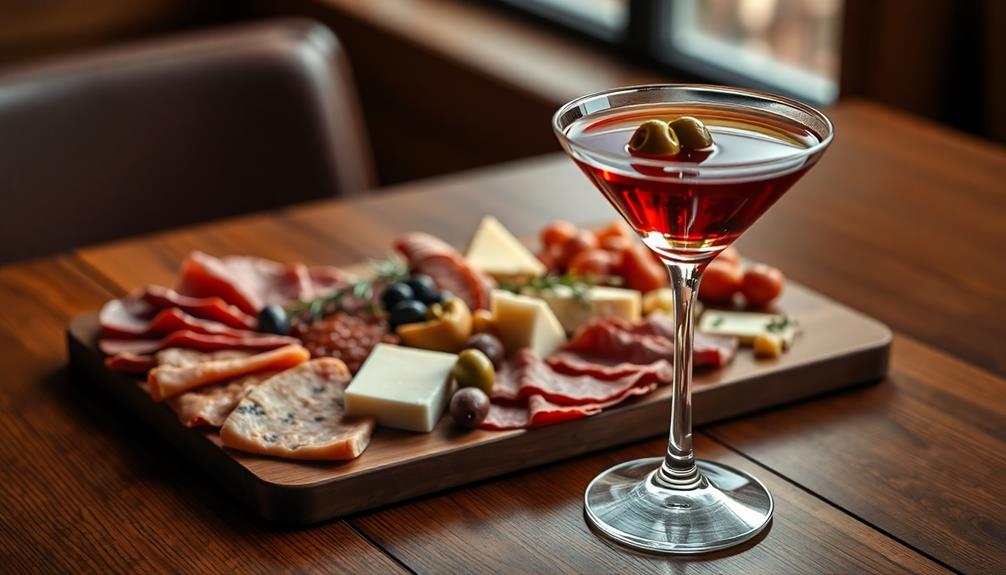
When it comes to classic cocktails, selecting the right food pairing can elevate your dining experience considerably. The interplay of flavors in your drink and dish can enhance both, creating a memorable meal.
Here are some classic cocktail and food pairings to contemplate:
- Dry Gin Martini: This crisp cocktail complements the brininess of fresh oysters perfectly, thanks to its botanical notes.
- Margarita: The acidity in a Margarita cuts through the richness of tacos, balancing the meat's flavors and spices beautifully.
- Whiskey Sour: With its sweet and sour profile, a Whiskey Sour pairs wonderfully with smoky barbecue ribs, particularly those slathered in barbecue sauce, enhancing and revitalizing the overall taste.
- Negroni: The bitter complexity of a Negroni works well with charcuterie boards, balancing the richness of cured meats and fatty cheeses.
These classic pairings not only highlight the unique characteristics of each cocktail but also enhance the flavors of the food, making your dining experience truly enjoyable.
Experimenting With Unique Combinations
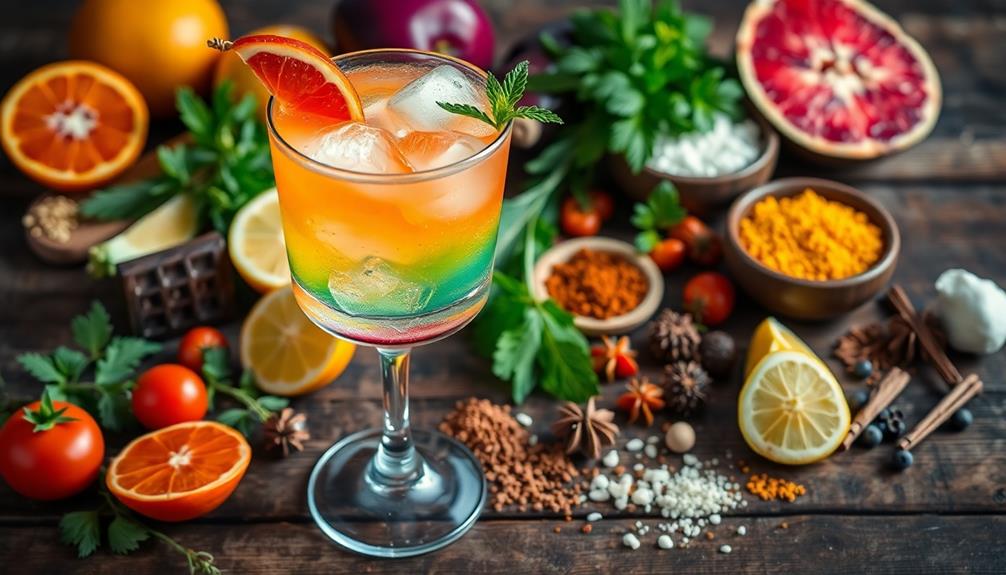
Exploring unique combinations can be a thrilling adventure for your palate, offering a chance to step beyond traditional pairings. When you experiment with pairing cocktails, consider how contrasting flavors can elevate your culinary experience.
For instance, a invigorating Mint Julep paired with crispy fried chicken creates an exciting interplay, where the savory notes of the chicken are beautifully contrasted by the minty freshness. The balance of flavors in this combination not only excites the palate but also highlights the beauty of how different cultures’ food traditions can complement each other. The Southern-style fried chicken, with its rich and hearty taste, finds a surprising yet harmonious partner in the refreshing Mint Julep, often associated with Kentucky. Together, they showcase how seemingly distinct items, born from different cultural contexts, can come together to create something truly unique.
Utilizing a flavor wheel can be invaluable in this exploration. It helps you identify dominant flavors in both your cocktails and food, guiding you towards innovative pairings.
Think bold: a Spicy Margarita with mango salsa balances heat and sweetness, culminating in a dynamic flavor explosion.
Don't shy away from seasonal ingredients either. A Fall Spiced Old Fashioned served alongside roasted butternut squash highlights warming spices and earthy undertones, perfect for autumn gatherings.
Finally, gather friends for tasting sessions. Their feedback can refine your pairing skills, encouraging you to venture into unconventional combinations. You never know what new favorites may arise from these delightful experiments!
Embrace the unexpected and let your palate guide you on this flavorful journey.
Frequently Asked Questions
How Do You Pair Food and Cocktails?
When you pair food and cocktails, focus on matching the dish's intensity with the cocktail's strength. Experiment with complementary and contrasting flavors, considering sweetness, acidity, and presentation to create a delightful dining experience.
What Food Compliments Cocktails?
Think of food and cocktails as dance partners; they should complement each other. Rich dishes crave citrusy cocktails, while smoky meats enjoy sweet ones. Balance flavors, and you'll create a delightful dining experience that sings.
What Are the Basics of Pairing Beverages and Food?
When you pair beverages and food, focus on balancing flavors. Consider contrasting tastes, matching body and acidity, and ensuring sweetness aligns. This harmony enhances your dining experience, making every bite and sip more enjoyable.
What Is the Science Behind Cocktails?
You explore the science behind cocktails by balancing flavors, understanding acidity, and considering texture. This knowledge helps you create delightful drinks that enhance your overall experience and elevate your appreciation for diverse flavor interactions.
Conclusion
To sum up, mastering the science of food pairing with cocktails can elevate your dining experience. Did you know that nearly 90% of our taste perception comes from our sense of smell? By understanding flavor profiles and experimenting with unique combinations, you can create delicious pairings that surprise and delight your palate. So next time you're mixing drinks or preparing a meal, don't hesitate to get creative—your taste buds will thank you!
